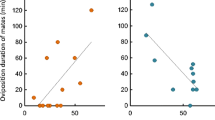Abstract
We examined the relative importance of climatic factors and population density to territorial start time ofVanessa atalanta males. Start time varies with solar altitude and therefore with seasons. We removed seasonal effects by converting start times to corresponding solar altitudes. Start time solar altitude correlates primarily with ambient temperature (T a) and secondarily with substrate temperature (T s), regardless of cloud cover. Overcast cloud cover resulted in later not earlier start times as expected from reduced solar radiation (R⊙) levels. R⊙ may affect start time indirectly by affectingT s and later start times under overcast skies may be a result ofT s. Start times under solid overcast but not under broken overcast were different than under clear skies, suggesting thatV. atalanta males can use dim sun or blue patches in broken overcast as a start time cue. Early interaction frequency is correlated withT a and wind direction, but not with start time itself, suggesting that male population density is unimportant compared with climatic factors. We conclude thatV. atalanta has a climate-dependent start time but, also, that maintaining a relatively fixed daily schedule is more important to males than is achieving an optimal body temperature while perching.
Similar content being viewed by others

References
Alcock, J. (1985). Hilltopping in the nymphalid butterflyChlosyne california (Lepidoptera).Am. Midl. Nat. 113 69–75.
Alcock, J., and O'Neill, K. M. (1986). Density-dependent mating tactics in the Grey Hairstreak,Strymon melinus (Lepidoptera: Lycaenidae).J. Zool., Lond. 209 105–113.
Baker, R. R. (1972). Territorial behavior of the mymphalid butterfliesAglais urticae andInachis io (L.).J. Anim. Ecol. 41 453–469.
Bitzer, R. J. and Shaw, K. C. (1979). Territorial behavior of the Red Admiral,Vanessa atalanta (L.) (Lepidoptera: Nymphalidae).J. Res. Lepid. 18 36–49.
Bitzer, R. J., and Shaw, K. C. (1983). Territorial behavior ofNymphalis antiopa andPolygonia comma (Nymphalidae).J. Lepid. Soc. 37 1–13.
Brown, W. D., and Alcock, J. (1991). Hilltopping by the red admiral butterfly: Mate searching alongside congeners.J. Res. Lepid. 29 1–10.
Campbell, G. S. (1977).An Introduction to Environmental Biophysics, Springer-Verlag, New York.
Clench, H. K. (1966). Behavioral thermoregulation in butterflies.Ecology 47 1021–1034.
Davies, N. B. (1978). Territorial defence in the speckled wood butterfly,Pararge aegeria: The resident always wins.Anim. Behav. 26 138–147.
Dennis, R. L. H. (1982). Mate location strategies in the wall brown butterfly,Lasiommata megera L. (Lepidoptera: Satyridae). Wait or seek?Entomol. Rec. J. Var. 94 209–214;95: 7–10.
Dennis, R. L. H., and Williams, W. R. (1987). Mate-locating behaviour of the large skipper butterflyOchlodes venata: Flexible strategies and spatial components.J. Lepid. Soc. 41 45–64.
Gaugler, R., and Schutz, S. (1989). Environmental influences on hovering behavior ofTabanus nigrovittatus andT. conterminus (Diptera: Tabanidae).J. Insect Behav. 2 775–786.
Heinrich, B. (1981).Insect Thermoregulation, John Wiley and Sons, New York.
Heinrich, B. (1986). Comparative thermoregulation of four montane butterflies of different mass.Physiol. Zool. 59 616–626.
Iwasa, Y., and Obara, Y. (1989). A game model for the daily activity schedule of the male butterfly.J. Insect Behav. 2 589–608.
Krogh, A., and Zeuthen, E. (1941). The mechanism of flight preparation in some insects.J. Exp. Biol. 18 1–10.
Larsen, T. B. (1993). Butterfly mass transit.Nat. Hist. 102 30–39.
Monteith, J. L., and Unsworth, M. H. (1990).Principles of Environmental Physics, 2nd ed., Edward Arnold, London.
Nautical Almanac Office, U.S. Naval Observatory (1987–1991).The Astronomical Almanac for the Year(s) 1987–1991, U.S. Government Printing Office, Washington, DC.
Polcyn, D. M., and Chappell, M. A. (1986). Analysis of heat transfer inVanessa butterflies: Effects of wing position and orientation to wind and light.Physiol. Zool. 59 706–716.
Rutowski, R. L. (1991). The evolution of male mate-locating behavior in butterflies.Am. Nat. 138 1121–1139.
Rutowski, R. L., Dickinson, J. L., and Terkanian, B. (1991). Behavior of male Desert Hackberry Butterflies,Asterocampa leilia (Nymphalidae) at perching sites used in mate location.J. Res. Lepid. 30 129–139.
Scott, J. A. (1974). Mate-locating behavior of butterflies.Am. Midl. Nat. 91 103–117.
Shields, O. (1967). Hilltopping.J. Res. Lepid. 11 99–127.
Shreeve, T. G. (1984). Habitat selection, mate location and microclimatic constraints on the activity of the speckled wood butterfly,Pararge aegeria. Oikos 42 371–377.
Swanson, H. F. (1979).Butterfly Revelations, Rollins Press, Orlando, FL.
Tsuji, J. S., Kingsolver, J. G., and Watt, W. B. (1986). Thermal physiological ecology ofColias butterflies in flight.Oecologia 69 161–170.
Vielmetter, W. (1958). Physiologie des Verhaltens zur Sonnenstrahlung bei dem TagfalterArgynnis paphia L. I. Untersuchungen im Freiland. (Physiology of the reaction to solar radiation by the butterflyArgynnis paphia L. I. Investigations in the field.)J. Insect Physiol. 2 13–37.
Wickman, P.-O. (1985a). The influence of temperature on the territorial and mate locating behaviour of the small heath butterfly,Coenonympha pamphilus (L.) (Lepidoptera: Satyridae).Behav. Ecol. Socibiol. 16 233–238.
Wickman, P.-O. (1985b). Territorial defence and mating success in males of the small heath butterfly,Coenonympha pamphilus (L.) (Lepidoptera: Satyridae).Anim. Behav. 33 1162–1168.
Wickman, P.-O. (1988). Dynamics of mate-searching behavior in a hilltopping butterfly,Lasiommata megera (L.): The effects of weather and male density.Zool. J. Linn. Soc. 93 357–377.
Wickman, P.-O., and Wiklund, C. (1983). Territorial defence and its seasonal decline in the speckled wood butterfly(Pararge aegeria).Anim. Behav. 31 1206–1216.
Author information
Authors and Affiliations
Rights and permissions
About this article
Cite this article
Bitzer, R.J., Shaw, K.C. Territorial behavior of the red admiral,Vanessa atalanta (Lepidoptera: Nymphalidae) I. The role of climatic factors and early interaction frequency on territorial start time. J Insect Behav 8, 47–66 (1995). https://doi.org/10.1007/BF01990969
Accepted:
Issue Date:
DOI: https://doi.org/10.1007/BF01990969



